
Steam shovel
Encyclopedia
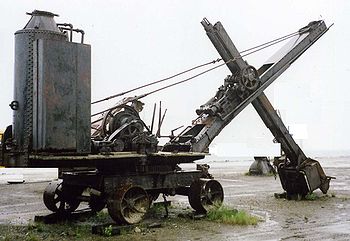
Steam engine
A steam engine is a heat engine that performs mechanical work using steam as its working fluid.Steam engines are external combustion engines, where the working fluid is separate from the combustion products. Non-combustion heat sources such as solar power, nuclear power or geothermal energy may be...
excavating machine designed for lifting and moving material such as rock and soil
Soil
Soil is a natural body consisting of layers of mineral constituents of variable thicknesses, which differ from the parent materials in their morphological, physical, chemical, and mineralogical characteristics...
. It is the earliest type of power shovel or excavator
Excavator
Excavators are heavy construction equipment consisting of a boom, stick, bucket and cab on a rotating platform . The house sits atop an undercarriage with tracks or wheels. A cable-operated excavator uses winches and steel ropes to accomplish the movements. They are a natural progression from the...
. They played a major role in public works in the 19th and early 20th century, being key to the construction of railroads and the Panama Canal
Panama Canal
The Panama Canal is a ship canal in Panama that joins the Atlantic Ocean and the Pacific Ocean and is a key conduit for international maritime trade. Built from 1904 to 1914, the canal has seen annual traffic rise from about 1,000 ships early on to 14,702 vessels measuring a total of 309.6...
. The development of simpler, cheaper diesel-powered
Diesel engine
A diesel engine is an internal combustion engine that uses the heat of compression to initiate ignition to burn the fuel, which is injected into the combustion chamber...
shovels
Excavator
Excavators are heavy construction equipment consisting of a boom, stick, bucket and cab on a rotating platform . The house sits atop an undercarriage with tracks or wheels. A cable-operated excavator uses winches and steel ropes to accomplish the movements. They are a natural progression from the...
caused steam shovels to fall out of use in the 1930s.
Origins and development
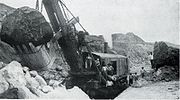
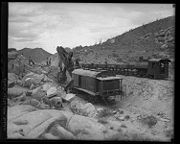
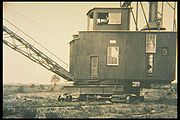
William Otis
William Otis was an American inventor of the steam shovel. Otis received a patent for his creation on February 24, 1839.In 1839, William Smith Otis, civil engineer of Philadelphia, Pennsylvania, was issued a US patent for the steam shovel for excavating and removing earth for railroads or canals....
, who received a patent
Patent
A patent is a form of intellectual property. It consists of a set of exclusive rights granted by a sovereign state to an inventor or their assignee for a limited period of time in exchange for the public disclosure of an invention....
for his design in 1839.
The first machines were known as 'partial-swing', since the dipper arm could not rotate through 360 degrees. They were built on a railway chassis, on which the boiler
Boiler (steam generator)
A boiler or steam generator is a device used to create steam by applying heat energy to water. Although the definitions are somewhat flexible, it can be said that older steam generators were commonly termed boilers and worked at low to medium pressure but, at pressures above this, it is more...
and movement engine
Steam engine
A steam engine is a heat engine that performs mechanical work using steam as its working fluid.Steam engines are external combustion engines, where the working fluid is separate from the combustion products. Non-combustion heat sources such as solar power, nuclear power or geothermal energy may be...
s were mounted. The shovel arm and driving engines were mounted at one end of the chassis, which accounts for the limited swing. Bogie
Bogie
A bogie is a wheeled wagon or trolley. In mechanics terms, a bogie is a chassis or framework carrying wheels, attached to a vehicle. It can be fixed in place, as on a cargo truck, mounted on a swivel, as on a railway carriage/car or locomotive, or sprung as in the suspension of a caterpillar...
s with flanged wheels were fitted, and power was taken to the wheels by a chain drive to the axles. Temporary rail tracks were laid by workers where the shovel was expected to work, and repositioned as required.
Steam shovels became more popular in the latter half of the nineteenth century. Originally configured with chain hoists, the advent of steel cable
Wire rope
thumb|Steel wire rope Wire rope is a type of rope which consists of several strands of metal wire laid into a helix. Initially wrought iron wires were used, but today steel is the main material used for wire ropes....
in the 1870s allowed for easier rigging to the winches.
Later machines were supplied with caterpillar tracks, obviating the need for rails.
The full-swing, revolving shovel was developed in England
England
England is a country that is part of the United Kingdom. It shares land borders with Scotland to the north and Wales to the west; the Irish Sea is to the north west, the Celtic Sea to the south west, with the North Sea to the east and the English Channel to the south separating it from continental...
in 1884, and became the preferred format for these machines.
Expanding railway networks (in the US and the UK) fostered a demand for steam shovels. The extensive mileage of railways, and corresponding volume of material to be moved, forced the technological leap. As a result, steam shovels became commonplace.
During the 1930s steam shovels lost out to the simpler, cheaper diesel-powered
Diesel engine
A diesel engine is an internal combustion engine that uses the heat of compression to initiate ignition to burn the fuel, which is injected into the combustion chamber...
excavating
Excavator
Excavators are heavy construction equipment consisting of a boom, stick, bucket and cab on a rotating platform . The house sits atop an undercarriage with tracks or wheels. A cable-operated excavator uses winches and steel ropes to accomplish the movements. They are a natural progression from the...
shovels that were the forerunners of those still in use today. Open-pit mines were electrified at this time. Only after the Second World War, with the advent of robust high-pressure hydraulic hoses, did the more versatile hydraulic backhoe shovels take pre-eminence over the cable-hoisting winch shovels.
Many steam shovels remained at work on the railways of developing nations until diesel engines supplanted them. Most have since been scrapped.
History (US)
American manufacturers included the Marion Steam Shovel CompanyMarion Power Shovel
Marion Power Shovel Company designed, manufactured and sold steam shovels, excavators and dragline excavators for use in the construction and mining industries....
, which was founded in 1884, Erie, P and H, and Bucyrus-Erie Shovel Companies.
The booming cities in North America used shovels to dig foundations and basements for the early skyscraper
Skyscraper
A skyscraper is a tall, continuously habitable building of many stories, often designed for office and commercial use. There is no official definition or height above which a building may be classified as a skyscraper...
s.
The Panama Canal
Perhaps the most famous application of steam shovels is the digging of the Panama CanalPanama Canal
The Panama Canal is a ship canal in Panama that joins the Atlantic Ocean and the Pacific Ocean and is a key conduit for international maritime trade. Built from 1904 to 1914, the canal has seen annual traffic rise from about 1,000 ships early on to 14,702 vessels measuring a total of 309.6...
across the Isthmus of Panama
Isthmus of Panama
The Isthmus of Panama, also historically known as the Isthmus of Darien, is the narrow strip of land that lies between the Caribbean Sea and the Pacific Ocean, linking North and South America. It contains the country of Panama and the Panama Canal...
. One hundred and two shovels worked in that decade-long dig. Of these, seventy-seven were built by Bucyrus ; the remainder were Marion shovels. These machines 'moved mountains' in their labours. The shovel crews would race to see who could move the most dirt.
Mining
Steam shovels assisted mining operations: the iron mines of Minnesota, the copper mines of Chile and Montana, placer mines of the KlondikeKlondike, Yukon
The Klondike is a region of the Yukon in northwest Canada, east of the Alaska border. It lies around the Klondike River, a small river that enters the Yukon from the east at Dawson....
– all had earth-moving equipment. But it was with the burgeoning open-pit mines – first in Bingham Canyon, Utah – that shovels came into their own. The shovels systematically removed hillsides. As a result, steam shovels were used around the world from Australia to Russia to coal mines in China. Shovels were also used for construction, road and quarry work.
Later history (US)
Steam shovels came into their own in the 1920s with the publicly-funded road building programs around North America. Thousands of miles of State Highways were built in this time period, together with new factories, such as Henry Ford's River Rouge PlantRiver Rouge Plant
The Ford River Rouge Complex is a Ford Motor Company automobile factory complex located in Dearborn, Michigan, along the Rouge River, upstream from its confluence with the Detroit River at Zug Island...
, and many docks, ports, buildings, and grain elevators.
Preservation
Most steam shovels have been scrapped, although a few reside in industrial museums and private collections.The Le Roy Marion
The world's largest steam shovel surviving intact is a 1906-built Marion machine, located in the small American town of Le Roy, New YorkLe Roy (town), New York
Le Roy, or more commonly LeRoy, is a town in Genesee County, New York, United States. The population was 7,790 at the 2000 census. The town is named after one of the original land owners, Herman Le Roy....
. It was listed on the National Register of Historic Places
National Register of Historic Places
The National Register of Historic Places is the United States government's official list of districts, sites, buildings, structures, and objects deemed worthy of preservation...
in 2008.
Ruston Proctor Steam Navvy No 306
This machine was originally used at a chalk pit at ArleseyArlesey
Arlesey is a small industrial town and civil parish in the district of Central Bedfordshire in Bedfordshire. It is located on the border with Hertfordshire, about three miles north-west of Letchworth Garden City, four miles north of Hitchin and six miles south of Biggleswade. Arlesey railway...
, in Bedfordshire
Bedfordshire
Bedfordshire is a ceremonial county of historic origin in England that forms part of the East of England region.It borders Cambridgeshire to the north-east, Northamptonshire to the north, Buckinghamshire to the west and Hertfordshire to the south-east....
, England. After the pit was closed, the steam navvy was simply abandoned and 'lost' as the pit became flooded with water. By the mid-1970s, the area had become a local beauty spot, known as The Blue Lagoon (from chemicals from the quarry colouring the water), and after long periods of drought, the top of the rusty navvy could be seen protruding from the water. Ruston & Hornsby expert Ray Hooley heard of its existence, and organised the difficult task of rescuing it from the water-filled pit. Hooley arranged for its complete restoration to working order by apprentices at the Ruston-Bucyrus
Ruston-Bucyrus
Ruston-Bucyrus Ltd was an engineering company established in 1930 and jointly owned by Ruston and Hornsby based in Lincoln, England and Bucyrus-Erie based in Bucyrus, Ohio, the latter of which had operational control and into which the excavator manufacturing operation of Ruston and Hornsby was...
works. Subsequently it passed into the care of the Museum of Lincolnshire Life
Museum of Lincolnshire Life
The Museum of Lincolnshire Life is a museum in Lincoln, Lincolnshire, in the UK. The museum collection is a varied social history that reflects and celebrates the culture of Lincolnshire and its people from 1750 to the present day...
, although it is not known whether it remains in operational condition.
The navvy was recovered with hundreds of hours labour and free help from many organisations but today (2010) this Lincolnshire industrial monument stands unprotected with water allowed to pour down the boiler chimney. Many Lincolnshire residents and Ruston engineers wish to see this icon rescued.
1923 Bucyrus Model 50-B

Bucyrus International
Bucyrus International, Inc. , was an American surface and underground mining equipment company. Founded as Bucyrus Foundry and Manufacturing Company in Bucyrus, Ohio, in 1880, Bucyrus moved company headquarters to South Milwaukee, Wisconsin in 1893. In its early history, Bucyrus produced steam...
Model 50-B steam shovels were sent to the Panama Canal
Panama Canal
The Panama Canal is a ship canal in Panama that joins the Atlantic Ocean and the Pacific Ocean and is a key conduit for international maritime trade. Built from 1904 to 1914, the canal has seen annual traffic rise from about 1,000 ships early on to 14,702 vessels measuring a total of 309.6...
to build bridges, roads, and drains and remove the huge quantities of soil and rock cut from the canal bed. All the shovels but one were scrapped at Panama. The survivor was shipped back to California and then brought to Denver. In the early 1950s it was transported to Rollinsville by Roy and Russell Durand, who operated it at the Lump Gulch Placer, six miles south of Nederland, Colorado
Nederland, Colorado
The Town of Nederland is a Statutory Town established in 1885 located near the Continental Divide and Barker Meadow Reservoir in the mountains of southwest Boulder County, Colorado....
, until 1978. This steam shovel is the last operational Bucyrus Model 50-B, and is preserved at the Nederland Mining Museum.
Operation
A steam shovel comprises:- a bucket
- boom and 'dipper stick'
- boiler
- water tank and coal bunker
- steam engines and winches
- operator's controls
- a rotating platform on a truck, on which everything is mounted
- wheels (or sometimes caterpillar tracks or railroad wheels)
- a house (on the platform) to contain and protect 'the works'
The shovel has several individual operations: it can raise or luff the boom, rotate the house, or extend the dipper stick with the boom or crowd engine, and raise or lower the dipper stick.
When digging at a rock face, the operator simultaneously raises and extends the dipper stick to fill the bucket with material. When the bucket is full, the shovel is rotated to load a railway car or motor truck. The locking pin on the bucket flap is released and the load drops away. The operator lowers the dipper stick, the bucket mouth self-closes, the pin relocks automatically and the process repeats.
Steam shovels usually had a three-man crew: engineer, fireman and ground man. There was much jockeying to do to move shovels: rails and timber blocks to move; cables and block purchases to attach; chains and slings to rig; and so on. On soft ground, shovels used timber mats to help steady and level the ground. The early models were not self-propelled, rather they would use the boom to manoeuvre themselves.
Steam shovel manufacturers
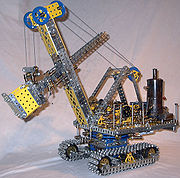
- Ball Engine Co.
- BucyrusBucyrus InternationalBucyrus International, Inc. , was an American surface and underground mining equipment company. Founded as Bucyrus Foundry and Manufacturing Company in Bucyrus, Ohio, in 1880, Bucyrus moved company headquarters to South Milwaukee, Wisconsin in 1893. In its early history, Bucyrus produced steam...
- Erie
- Marion Steam Shovel Dredge CompanyMarion Power ShovelMarion Power Shovel Company designed, manufactured and sold steam shovels, excavators and dragline excavators for use in the construction and mining industries....
- Moore Speedcrane (later Manitowoc CranesManitowoc CranesManitowoc Cranes is a division of The Manitowoc Company, Inc in the United States. Manitowoc Cranes produces four brands of cranes and has two service brands, Manitowoc Crane Care and Manitowoc Finance.- History :...
) - Northwest Shovels
- Vulcan Iron WorksVulcan Iron WorksSince Vulcan was the Roman god of fire and smithery, the name was an obvious choice for an iron foundry or mechanical engineering works in the nineteenth century, both in England, the birthplace of the Industrial Revolution, and in the United States.-England:...
European manufacturers:
- DemagDemagDemag or Demag Cranes AG is a German heavy equipment manufacturer now controlled by US based Terex. The roots of Demag date back prior to its formation, but became Märkische Maschinenbau-Anstalt, Ludwig A.-G in 1906 as the biggest crane building company in Germany employing 250-300 people...
(Germany) - FiorentiniFiorentiniThe Fiorentini are a noble Italian family from the Valsugana.Engineer Filippo Fiorentini founded the Fiorentini & C. S.p.A. factory of excavators in 1919 in Rome, Italy. He imported and distributed construction equipment. During the time of Fascism, restrictions banned import and Ing...
(Italy) - Lubecker
- MenckMenckMenck & Hambrock was a Hamburg-based German steam and diesel shovel builder.-Beginnings:The company was founded in 1868 by Johannes Menck and Diedrich Hambrock to build boilers and steam engines. Their first excavator was constructed in 1888. Even before the First World War, Menck was a world-class...
- Newton & Chambers (UK)
- Orenstein and Koppel GmbHOrenstein and Koppel GmbHOrenstein & Koppel was a major German engineering company specialising in railway vehicles, escalators, and heavy equipment. It was founded on April 1, 1876 in Berlin by Benno Orenstein and Arthur Koppel....
(Germany) - Ruston & Hornsby (UK)
Power shovels
Large, multi-ton mining shovels still use the cable-lift shovel arrangement.In the 1950s and 1960s Marion Shovel built massive stripping shovels for coal operations in the Eastern US. Shovels of note were the Marion 360, the Marion 5900, and the Marion 6360 – with a 180 cubic yards (137.6 m³) bucket – while Bucyrus constructed one of the most famous monsters: the Big Brutus
Big Brutus
Big Brutus is the nickname of the Bucyrus-Erie model 1850B electric shovel, which was the second largest of its type in operation in the 1960s and 1970s. It is currently the centerpiece of a mining museum in West Mineral, Kansas.-Description:...
, the largest power shovel ever built and the largest still in existence. The GEM of Egypt (GEM standing for "Giant Excavating Machine" and Egypt referring to the Egypt Valley in Belmont County
Belmont County, Ohio
Belmont County is a county located in the U.S. state of Ohio. It is part of the Wheeling, West Virginia Metropolitan Statistical Area. As of 2010, the population was 70,400. Its county seat is St. Clairsville...
, eastern Ohio where it was first put to use), which operated from 1967 to 1988, was of comparable size; it has since been dismantled.http://stripmine.org/gem_01.htm
Although these big machines are still called steam shovels, they are more correctly known as power shovels since they use electricity to wind their winches.
Power shovel/dragline manufacturers
- Bucyrus InternationalBucyrus InternationalBucyrus International, Inc. , was an American surface and underground mining equipment company. Founded as Bucyrus Foundry and Manufacturing Company in Bucyrus, Ohio, in 1880, Bucyrus moved company headquarters to South Milwaukee, Wisconsin in 1893. In its early history, Bucyrus produced steam...
- Insley Manufacturing Co.Insley Manufacturing Co.The Insley Manufacturing Company produced heavy construction equipment, and was based in Indianapolis Indiana.-History:The company was founded in 1907 by William Henry Insley . The company holds many patents for cable-operated digging equipment such as Dragline excavators and power shovels...
- Komatsu
- Lima Locomotive WorksLima Locomotive WorksLima Locomotive Works was an American firm that manufactured railroad locomotives from the 1870s through the 1950s. The company took the most distinctive part of its name from its main shops location in Lima, Ohio. The shops were located between the Baltimore & Ohio's Cincinnati-Toledo main line...
- Link Belt
- Marion Power ShovelMarion Power ShovelMarion Power Shovel Company designed, manufactured and sold steam shovels, excavators and dragline excavators for use in the construction and mining industries....
- P&H Mining Equipment
- Priestman BrosPriestman BrothersPriestman Brothers was an engineering company based in Kingston upon Hull, UK that manufactured diggers, dredgers, cranes and other industrial machinery...
(UK) - Ransomes & Rapier (UK)
- Ruston-BucyrusRuston-BucyrusRuston-Bucyrus Ltd was an engineering company established in 1930 and jointly owned by Ruston and Hornsby based in Lincoln, England and Bucyrus-Erie based in Bucyrus, Ohio, the latter of which had operational control and into which the excavator manufacturing operation of Ruston and Hornsby was...
(UK)
In fiction
Steam shovels have found literary fame with the children's classic Mike Mulligan and His Steam ShovelMike Mulligan and His Steam Shovel
Mike Mulligan and His Steam Shovel is a classic children's book by Virginia Lee Burton, the author and illustrator of the Caldecott Medal-winning The Little House...
. Another power shovel features towards the climax of the children's book Are You My Mother?
Are You My Mother?
Are You My Mother? is a children's book by P. D. Eastman published by Random House Books for Young Readers on June 12, 1960 as part of their Beginner Books series.-Plot summary:...
by P. D. Eastman – the little bird is returned to its nest by a "Snort" – but this is not necessarily a steam shovel.
In the Thomas and Friends TV series, a steam shovel called Ned appears as a minor character. In the Australian children's TV series Mr. Squiggle, Bill the Steam Shovel provides comic relief and produces steam from his "nose" when he laughs. In an episode of Futurama
Futurama
Futurama is an American animated science fiction sitcom created by Matt Groening and developed by Groening and David X. Cohen for the Fox Broadcasting Company. The series follows the adventures of a late 20th-century New York City pizza delivery boy, Philip J...
, Bender
Bender
- Places:* Bender, Moldova, also known as Bendery or Tighina* Bender, California, a former settlement in Fresno County, California* Bender Bayla District, a district of Bari, Somalia- Fiction :...
is quoting as saying "When I grow up, I wanna be a steam shovel!"
Exceptional Historic Uses
- During the Spanish fluSpanish fluThe 1918 flu pandemic was an influenza pandemic, and the first of the two pandemics involving H1N1 influenza virus . It was an unusually severe and deadly pandemic that spread across the world. Historical and epidemiological data are inadequate to identify the geographic origin...
epidemic in 1918, so many people were dying that steam shovels were needed to dig the mass graves.
See also
- Steam craneSteam craneA steam crane is a crane powered by a steam engine. It may be fixed or mobile and, if mobile, it may run on rail tracks, caterpillar tracks, road wheels, or be mounted on a barge...
- Crane (railroad)Crane (railroad)A railroad crane, is a type of crane used on a railroad for one of three primary uses: freight handling in goods yards, permanent way maintenance, and accident recovery work...
- Dragline excavatorDragline excavatorA dragline excavator is a piece of heavy equipment used in civil engineering and surface mining.In civil engineering the smaller types are used for road, port construction, and as pile driving rigs. The larger types are used in strip-mining operations to move overburden above coal, and for...
- DredgeDredgeDredging is an excavation activity or operation usually carried out at least partly underwater, in shallow seas or fresh water areas with the purpose of gathering up bottom sediments and disposing of them at a different location...
- Power shovel
- ExcavatorExcavatorExcavators are heavy construction equipment consisting of a boom, stick, bucket and cab on a rotating platform . The house sits atop an undercarriage with tracks or wheels. A cable-operated excavator uses winches and steel ropes to accomplish the movements. They are a natural progression from the...
External links
- Photo of the Le Roy Marion shovel at work
- The Long Journey of a Steam Shovel – the story of a preserved Ruston-BucyrusRuston-BucyrusRuston-Bucyrus Ltd was an engineering company established in 1930 and jointly owned by Ruston and Hornsby based in Lincoln, England and Bucyrus-Erie based in Bucyrus, Ohio, the latter of which had operational control and into which the excavator manufacturing operation of Ruston and Hornsby was...
steam shovel in Spain – Video of a working steam shovel and a clamshell-fitted steam crane - Bucyrus Official Website
- Steam shovel photo register, including many working shovels.
- Copper Range Steam Shovel X-2
- Steam crane

